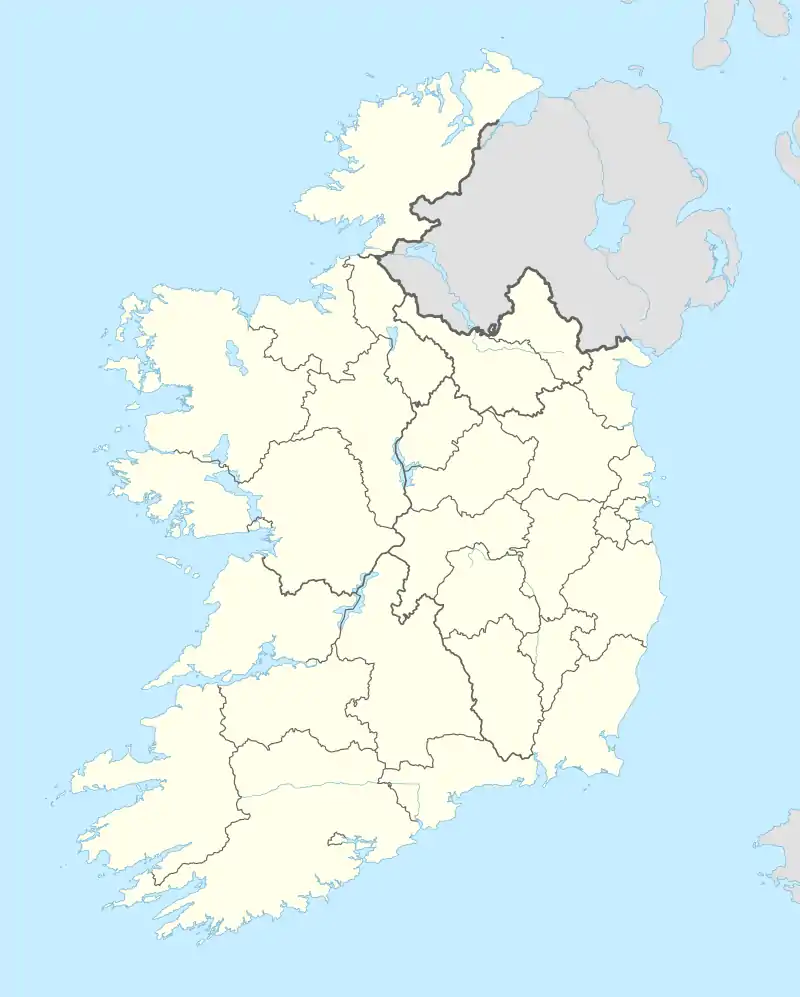Ballyhea
Ballyhea or Ballyhay (Irish: Bealach Átha, meaning "way of the ford")[1] is a townland and civil parish in north County Cork, Ireland, on the main N20 Cork–Limerick road, 3.5 km south of Charleville. It lies approximately 110 m above sea level.[2]
Ballyhea
Bealach Átha Ballyhay | |
|---|---|
Civil parish | |
 Ballyhea Location in Ireland | |
| Coordinates: 52.326752°N 8.667065°W | |
| Country | Ireland |
| Province | Munster |
| County | County Cork |
| Irish Grid Reference | R544177 |
Area and etymology
Ballyhea covers a wide area and has five graveyards. These relate to the five parishes of Aglishdrinagh, Ardskeagh, Ballyhea (Ballyhay), Cooline, and Imprick which make up the broad area. It borders Newtownshandrum, Charleville, Ardpatrick, Effin, Churchtown, Liscarroll and Buttevant. Previously named as Ballyhaura in early 19th century publications such as the Union Gazetteer for Gt. Br. & Ireland. [3]
Ballyhea means "place of Aodb or Aedh". Aodb had his residence in the 900's in the townland known as Lisballyhea. His clan was said to be one of the earliest to settle in the area.
History
The main estate in the area was one of a group owned by the FitzGerald family. Known as "Castle Dodd" or "Castle Dod", the estate's main house incorporated the structure of an earlier castle, and became the home of the Harrison family from the mid-18th century. Becoming known as Castle Harrison, the house fell into disuse after the estate was acquired by the Irish Land Commission in 1956. Castle Harrison was subsequently demolished.[4][5]
A Ballyhea man, called William Burke (brother of one of the accused) from Ballyhea, played a role in the Doneraile Conspiracy of 1829, by riding from Doneraile to Derrynane in County Kerry, to retain Daniel O’Connell as legal counsel. Willian Burke died on 7 April 1876, and was buried in Shandrum Cemetery, near Charleville.
Con O'Brien (1883-1946), known as Bard of Ballyhea, wrote numerous poems about Ballyhea, and the surrounding area. These were published in a 1981 book called The Poems of Con O'Brien the Bard of Ballyhea, published by Charleville (County Cork) Oriel Press.
Religion
There is one Roman Catholic church, St. Mary's, and a relatively modern cemetery, linked to an older cemetery off the Limerick Road. There is an older Catholic church in the graveyard in Ballyhea (Ballyhay), built circa 1200 by the Norman family, the De Cogans. It ceased religious service circa 1800 and has fallen into ruin since then. In 1831, the population was judged to be 7,400 Catholics and 340 Protestants,[6] with only 15 members belonging to the Church of England.[7]
Sport
Ballyhea GAA club was formed in 1884. The club has won County Championships in Senior, Intermediate, Junior and Juvenile hurling. In later years a Camogie Club was set up and three County Titles have been won by this club. The hurling team regraded to intermediate at the end of 2003. It took them until the 2015 season to return to senior.[8]
Transport
Ballyhea is on the main Limerick–Cork bus route with a stop near the parish church.
The nearby town of Charleville has a station on Cork-Dublin railway line (formerly the Great Southern Line).
Amenities
Ballyhea has a series of marked mountain walk ways at Ballinboola and is part of the Ballyhoura Trail. There is a large artificial lake (40 acres), created by the extraction of gravel, with a range of wildlife; it is privately owned.
The greater Ballyhea area has a number of businesses, including a Lidl warehouse on the N20 at Pike Cross, and Charleville Foods (aka Galtee Meats and Horgans).
Community groups
Ballyhea Community Council evolved in the 1970s from a Munitir Na Tíre group. The council's activities include organising a Christmas meal for the elderly of the parish every year.
A group of parents came together in 2000 to form the Ballyhea Pre-school Group. A Parent & Toddler Group was started within the first month of the group's existence, with a babysitters network being created in 2002.
The Ballyhea National School Parent Association was setup in 2004 to fundraise for the national school.
Bank bailout marches
Ballyhea residents were noted for their weekly marches through the village, beginning in February 2011 to protest against the taxpayer-funded bailout of banks in Ireland. A prominent spokesperson for the residents was activist Diarmuid O'Flynn, who was involved in documenting bank bailout payments as they happened.[9][10][11] The final march took place on 8 March 2020.[12]
References
- "Bealach Átha / Ballyhay". logainm.ie. Placenames Database of Ireland. Retrieved 29 July 2020.
- "Elevation contour line". Wind Report view. Ordnance Survey Ireland. Archived from the original on 29 August 2012.
- Brown, Thomas (1807). "Union Gazetteer for Gt. Br. & Ireland". Retrieved 11 June 2018.
- "Castle Harrison". Landedestates.nuigalway.ie. 18 May 2011. Retrieved 18 June 2015.
- "Castle Harrison - lordharrisonfamily". Retrieved 18 June 2015.
- Shee, William (1849). "Three Letters addressed to the Rev. J. Fitzpatrick on the justice and policy of appropriating a portion of the revenues of the Irish Protestant Church to the increase and maintenance of Church Accommodation for the Catholic people of Ireland". Retrieved 11 June 2018.
- Ward, Matthew (1853). "English Items: Or, Microscopic Views of England and Englishmen". Retrieved 11 June 2018.
- Hurley, Denis (13 October 2014). "Ballyhea 'yes' at return to senior ranks". Irish Examiner. Archived from the original on 19 March 2015. Retrieved 13 October 2014.
- Khaleeli, Homa (5 January 2012). "The Irish village that said 'no' to austerity". The Guardian. Archived from the original on 19 March 2015. Retrieved 5 January 2012.
- Jardine, Nick (6 January 2012). "Every Sunday, This Tiny Irish Village Protests Against Austerity". Business Insider. Archived from the original on 19 March 2015. Retrieved 6 January 2012.
- Browne, Bill (31 January 2013). "'Ballyhea says no' goes global: Village protest makes news around the world". The Corkman. Retrieved 31 January 2013.
- "Final 'Ballyhea Says No' protest march in Cork village". RTÉ. 8 March 2020. Retrieved 27 December 2014.
